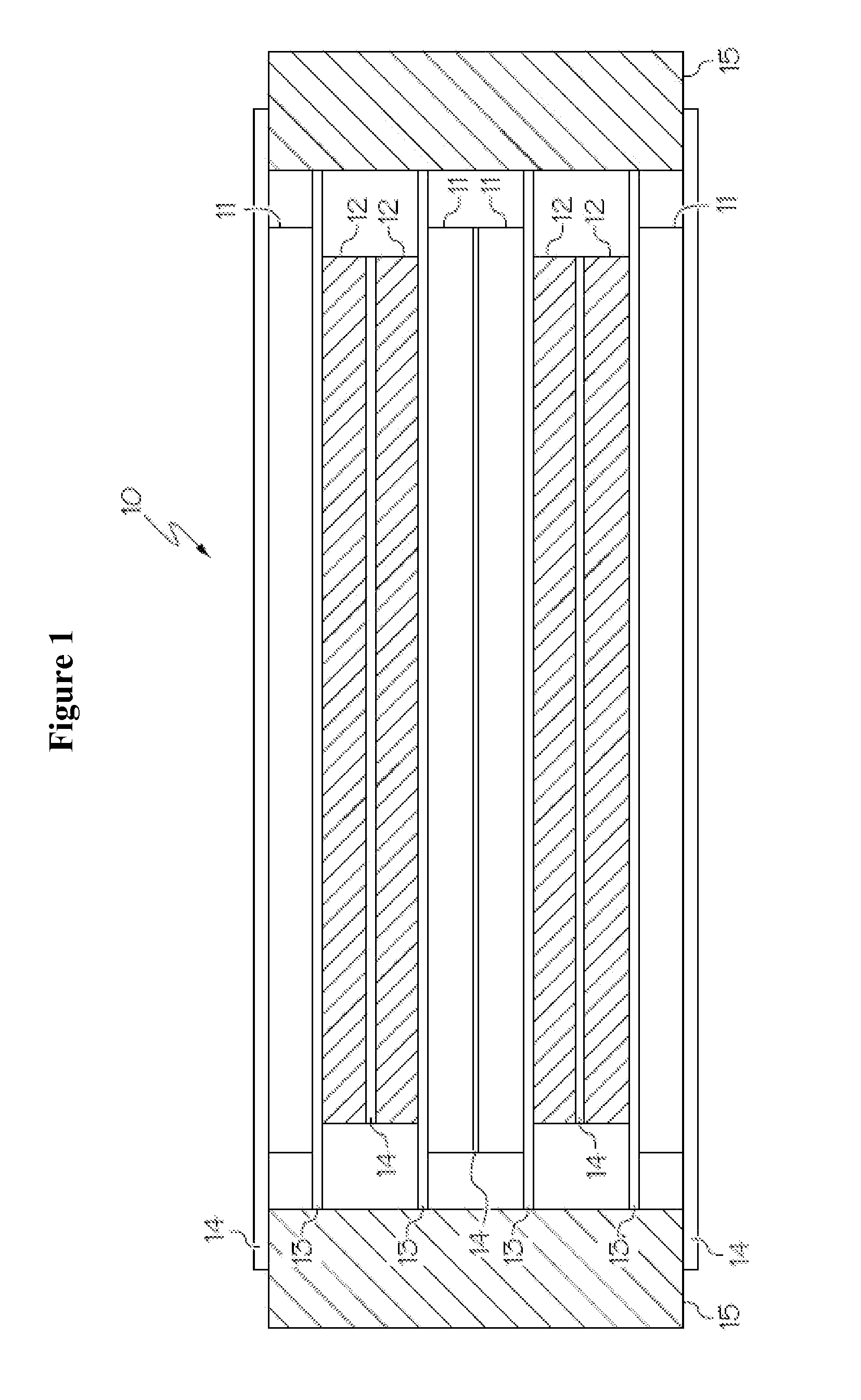Multifunctional cell for structural applications
a multi-functional, cell technology, applied in the direction of cell components, sustainable manufacturing/processing, batteries, etc., can solve the problems of significant constraints on the shape and size of the device, battery consumption a significant portion of the mass and volume allocated to the device, and the effect of adding weight and/or volume is not beneficial
- Summary
- Abstract
- Description
- Claims
- Application Information
AI Technical Summary
Benefits of technology
Problems solved by technology
Method used
Image
Examples
example 1
Fabrication of a Structural Battery
[0061]A structural battery design consists of a Li-ion bi-cell that incorporates:[0062]Two-bonded microporous polymeric separators[0063]Two outer single sided anodes with 10 micron copper foil current collector[0064]One double sided cathode with 15 micron aluminum foil current collector[0065]Liquid LiPF6 / mixed carbonate electrolyte absorbed into the electrodes and separator.
[0066]The outside anodes were cut from commercial stock, and the perimeter was cleaned using NMP to form the area for the perimeter seal. Next, two picture frame seals (with one extended side) were cut from 3 mil Suryln® film. The picture frames were then heat sealed to the anodes. Two pieces of Freya Energy safety separator modified by the manufacturer to improve adhesion and provide higher temperature tolerance were cut about 10 mm larger than the cathode. A double sided commercial cathode was cut to shape with a terminal so it extends beyond the perimeter of the anode. The ca...
example 2
Fabrication of Structural Cell with Perimeter Welded Outer Current Collectors
[0070]A structural battery design, as shown in FIG. 8, consists of a Li-ion bi-cell that incorporates:[0071]Two-bondable microporous polymeric separators[0072]Two outer single sided cathode with 25 micron aluminum foil current collector[0073]One double sided anode with 10 micron copper foil current collector[0074]Liquid LiPF6 / mixed carbonate electrolyte absorbed into the electrodes and separator.
[0075]The outside current collector was cut to size. The current collector may be two pieces or one piece folded. The cathode slurry was then patch coated by applying masking tape to the perimeter of the current collector and drawing down the slurry over the masked foil. The cathodes were then dried. Two pieces of special Freya Energy safety separator with improved adhesion and higher temperature tolerance were cut to size (about 10 mm larger than the anode). A double sided anode or hand coated double sided anode wa...
example 3
Fabrication of a Curved Battery
[0076]A curved structural battery design consists of a Li-ion bi-cell that incorporates:[0077]Two-bondable microporous polymeric separators[0078]Two outer single sided cathodes with 25 micron aluminum foil current collectors[0079]One double sided anode with a copper coated non-woven current collector[0080]Liquid LiPF6 / mixed carbonate electrolyte absorbed into the electrodes and separator.
[0081]The outside current collector was cut to size. The current collector may be two pieces or one piece folded. If the current collected is folded, the folded edge cannot be along the curve edge. The cathode slurry was then patch coated using a patterned screen (like silk screening) and drawing down the slurry over the screen. The cathodes were then dried and calendared. Two pieces of special Freya Energy safety separator with improved adhesion and higher temperature tolerance were cut to size (about 10 mm larger than the anode). A double sided anode was made by cutt...
PUM
| Property | Measurement | Unit |
|---|---|---|
| thickness | aaaaa | aaaaa |
| size | aaaaa | aaaaa |
| pressure | aaaaa | aaaaa |
Abstract
Description
Claims
Application Information
 Login to View More
Login to View More - R&D
- Intellectual Property
- Life Sciences
- Materials
- Tech Scout
- Unparalleled Data Quality
- Higher Quality Content
- 60% Fewer Hallucinations
Browse by: Latest US Patents, China's latest patents, Technical Efficacy Thesaurus, Application Domain, Technology Topic, Popular Technical Reports.
© 2025 PatSnap. All rights reserved.Legal|Privacy policy|Modern Slavery Act Transparency Statement|Sitemap|About US| Contact US: help@patsnap.com



